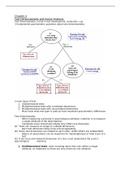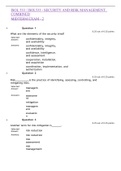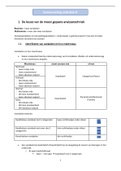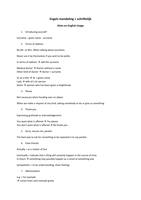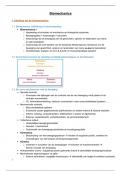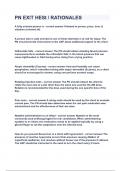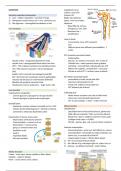-INSTRUCTION MANUAL-
Institution: Leiden University
Course: Psychometrics
,Content
1. Scaling and norming test scores .................................................................................................... 4
1.1 Scale score ................................................................................................................................. 4
1.2 Report scale scores ................................................................................................................... 4
1.3 Normed scale scores ................................................................................................................. 4
1.4 Norm table ................................................................................................................................... 5
2. Reliability ........................................................................................................................................... 6
2.1 Split-Half method........................................................................................................................ 6
2.2 Cronbach’s Alpha ....................................................................................................................... 6
3. Validity................................................................................................................................................ 7
3.1 MultiTrait-MultiMethod matrix ................................................................................................... 7
3.2 Total scores................................................................................................................................. 7
3.3 Correlation table ......................................................................................................................... 7
4. Construct Validity & Principal Component Analysis .................................................................... 9
4.1 Data inspection for PCA ............................................................................................................ 9
4.2 Performing PCA ......................................................................................................................... 9
4.2a PCA without rotation of axes .............................................................................................. 9
4.2b PCA with rotation of the axes ........................................................................................... 10
4.3 How many components? ........................................................................................................ 10
4.4 Explained variance total and per variable ............................................................................ 10
4.4a Communalities .................................................................................................................... 10
4.4b Eigenvalue greater than 1 ................................................................................................ 10
4.5 Component plot ........................................................................................................................ 10
4.6 Interpretation Components ..................................................................................................... 11
5. Item Response Theory .................................................................................................................. 12
5.1 Proportion / difficulty score ..................................................................................................... 12
5.2 Ability.......................................................................................................................................... 12
5.3 Relation difficulty & ability ....................................................................................................... 12
6. Test bias .......................................................................................................................................... 13
6.1 Centering test scores............................................................................................................... 13
6.2 Scatterplot: Criterion & Test scores ...................................................................................... 13
6.3 Dummy variable ....................................................................................................................... 14
6.4 Interaction variable................................................................................................................... 14
6.6 Intercept and slope coefficient ............................................................................................... 14
7. Discriminant Analysis..................................................................................................................... 15
2
,7.1 Summary Data & group Distribution...................................................................................... 15
7.2 ANOVA ...................................................................................................................................... 15
7.3 Preconditions/assumptions for DA ........................................................................................ 15
7.4 Matrix plot .................................................................................................................................. 15
7.5 Discriminant Analysis .............................................................................................................. 15
7.5b Predictive DA .......................................................................................................................... 16
7.6 Classification by means of Pythagoras Theorem................................................................ 16
3
, 1. Scaling and norming test scores
1.1 Scale score
Calculate scale scores by means of finding the mean of the items concerned:
Transform > Compute variable
- Target variable: name variable
- Numeric Expression: Mean.n(items concerned))
Mean.n:
- n is the number of items the participant should at least have answered and which
may thus not contain a missing value
- Used to not lose too much of your data due to missing values
1.2 Report scale scores
Statistics:
Analyze > Descriptives > Descriptives > Select relevant statistics
- Variable: Select variables concerned
Graphs:
Graphs > Legacy Dialogs > Histogram > Select variable concerned > OK
1.3 Normed scale scores
• Z-scores:
Analyze > Descriptive Statistics > Descriptives > OK
- Click save standardized values as variables
- Variables: Select variables concerned
- Options: unclick the boxes (not necessary)
Characteristics z-scores:
- SD=1
- Mean=0
- Negative: below the mean
- Positive: above the mean
- How to check whether z-scores are accurate:
Descriptive statistics > Descriptives > OK
- Variable: z-scores concerned
- Options: mean (0 in output?), sd (1 in output?), min&max
- Unclick save standardized values as variables
• T-scores:
Transform > Compute variable > OK
- Target variable: name variable (e.g.: Tlokfa_EN)
4


